Joy Neal Kidney's Blog, page 57
February 11, 2022
Clabe’s Pipe
“If a person’s eyes are a window to the soul, possessions are at least the back door.” – David LaBelle in The Great Picture Hunt 2.”
Could Clabe Wilson’s pipe be one way to regard him decades later?
This story is from 1927:
Clabe boosted Junior into his highchair and cut up some green beans and sausage for him. Twelve-year-old Delbert kept Danny on his lap as he ate. Danny wasn’t very hungry.
After the meal, Clabe raked back his chair, reached for his pipe and Prince Albert. He tamped a little tobacco into the bowl of pipe. He struck a wooden match on the bottom of his shoe. It popped into flame, which he held into the pipe. Clabe inhaled through the stem several times until it caught.
“Danny, come here.” Pipe in hand, Clabe reached for the mewling boy. Danny held up his arms for a lift onto his father’s lap. “What’s the problem, little feller? Did you miss your momma?”
Danny leaned against his dad, quietly pulling on an ear.
“Leora, do you think he might have an earache?”
“Might be. Why don’t you try warm smoke and see if it helps.”
Clabe had Danny sit up so he could blow warm smoke in his ear. All the eyes at the table watched. Danny settled back against the bib of his dad’s overalls, seemingly better.
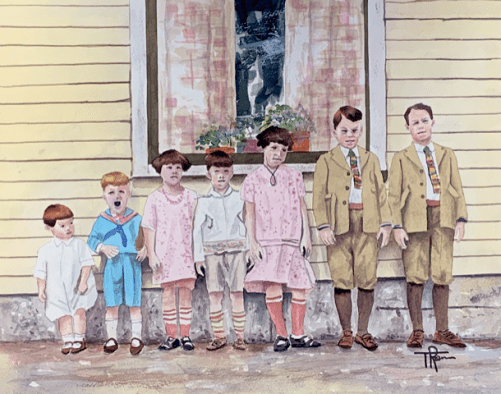 Danny Wilson, age 4, is the yawning boy in blue. 1927, south of Dexter. Watercolor by Audubon native Tim Ross, agricultural meteorologist at RFD-TV, Nashville.
Danny Wilson, age 4, is the yawning boy in blue. 1927, south of Dexter. Watercolor by Audubon native Tim Ross, agricultural meteorologist at RFD-TV, Nashville.—–
This little scene is in the first chapter in Leora’s Dexter Stories: The Scarcity Years of the Great Depression. Danny ended up needing surgery!
February 9, 2022
Surprise Valentine from Mom
When Gloria and I were in college, Mom sent us boxes of Drew’s Chocolates, which are made in our hometown, for Valentine’s Day. Every year she’d send us Drew’s, even after we had jobs of our own.
 Drew’s Chocolate box, now owned by the Dexter Museum
Drew’s Chocolate box, now owned by the Dexter MuseumEspecially for Valentine’s Day, Helen Drew began to buy red heart-shaped boxes, stamped with the candy shop’s name on the back. She’d fill them with luscious caramels, creams, chocolate covered nuts, nougats, and cherry chocolates. We’d share our bounty from Mom at work.
Gloria taught art at the Burton R. Jones Junior High in Creston for nearly three decades. Her fellow teachers looked forward to sampling this annual treat from home. She usually had it ready to share on the table in the teachers’ lounge.
One year she hadn’t unwrapped the box but set it on the table and said to go ahead and open it and enjoy. We didn’t realize that Mom decided she wouldn’t load us up with sugar and chocolate that year, so sent us each a surprise about the size of a Drew’s heart-shaped box.
When Gloria’s coworkers revealed to her what was in the box, she turned as red as the surprise gift. Mom had sent red shortie pajamas!
 Shortie pajamas on a mannequin
Shortie pajamas on a mannequinWhat a fun memory for the teachers at Burton R. Jones Junior High every Valentine’s Day after that, even after Mom quickly returned to sending Drew’s Chocolates.
A little history of Drew’s Chocolates.
February 7, 2022
Sweet Success Story by Rod Stanley, Dexter Historian
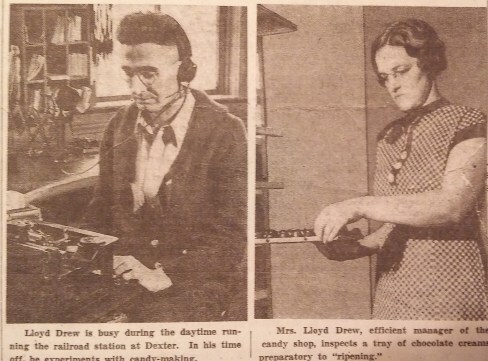 So in 1929, Drew’s Chocolates officially opened for business. The shop would be located in the basement of their house in Dexter on what eventually became US Highway 6. Mrs. Drew bought boxes of chocolate that came in 10 pound cakes. It had to be cut up into smaller pieces before it could be melted. Lloyd used a butcher knife to begin with but it was hard work. They contacted a man in Dexter that ran a machine shop. His name was Bob Boyd. Bob designed what he called a “guillotine” operated by a pulley that cut up the pieces of chocolate. Bob’s wife, Francis, later became the chief cook of most of the candy made in the shop. They used 3 different types of chocolate. Dark, Milk, and White. Each have different % of chocolate liquor.Fred Drew built the first mechanical dipper for Mrs. Drew from an old Ford transmission. It was nothing but a big steel bowl with the transmission turning it with an automatic stirrer. There was a heat source as well that kept the chocolate melted. This enable Mrs. Drew more chocolate to work with. It was not long before Fred Drew’s relatives built 2 stainless steel dippers. They were large enough so that 2 people could dip at the same time, one on each end. They also kept the chocolate at 91 degrees the perfect temp for chocolate dipping. The dipper stirred the chocolate constantly and flowed over a raised platform. There was a divider between the platform and the main basin of the dipper to keep candy from falling in. The candy was fork dipped. Fork dipping was one of the most skillful aspects of candy making. Mrs. Helen Clausen, who I knew well, was one of the most skilled dippers in the shop.
So in 1929, Drew’s Chocolates officially opened for business. The shop would be located in the basement of their house in Dexter on what eventually became US Highway 6. Mrs. Drew bought boxes of chocolate that came in 10 pound cakes. It had to be cut up into smaller pieces before it could be melted. Lloyd used a butcher knife to begin with but it was hard work. They contacted a man in Dexter that ran a machine shop. His name was Bob Boyd. Bob designed what he called a “guillotine” operated by a pulley that cut up the pieces of chocolate. Bob’s wife, Francis, later became the chief cook of most of the candy made in the shop. They used 3 different types of chocolate. Dark, Milk, and White. Each have different % of chocolate liquor.Fred Drew built the first mechanical dipper for Mrs. Drew from an old Ford transmission. It was nothing but a big steel bowl with the transmission turning it with an automatic stirrer. There was a heat source as well that kept the chocolate melted. This enable Mrs. Drew more chocolate to work with. It was not long before Fred Drew’s relatives built 2 stainless steel dippers. They were large enough so that 2 people could dip at the same time, one on each end. They also kept the chocolate at 91 degrees the perfect temp for chocolate dipping. The dipper stirred the chocolate constantly and flowed over a raised platform. There was a divider between the platform and the main basin of the dipper to keep candy from falling in. The candy was fork dipped. Fork dipping was one of the most skillful aspects of candy making. Mrs. Helen Clausen, who I knew well, was one of the most skilled dippers in the shop. Some other skilled dippers were: Betty Lenocker, Pearl Schaffer, Betty Wells, and Maxine Paullin. There probably others but these were the ones my Mom remembered. My Mom said,” Helen was so skilled she could dip candy in her sleep”. Mrs. Drew said, “if you were dipping right you could put a dime on your wrist and it would stay there”. You only used your fingers to control the fork. After the candy was dipped it was refrigerated in storage rooms between 56 and 60 degrees.
Some other skilled dippers were: Betty Lenocker, Pearl Schaffer, Betty Wells, and Maxine Paullin. There probably others but these were the ones my Mom remembered. My Mom said,” Helen was so skilled she could dip candy in her sleep”. Mrs. Drew said, “if you were dipping right you could put a dime on your wrist and it would stay there”. You only used your fingers to control the fork. After the candy was dipped it was refrigerated in storage rooms between 56 and 60 degrees.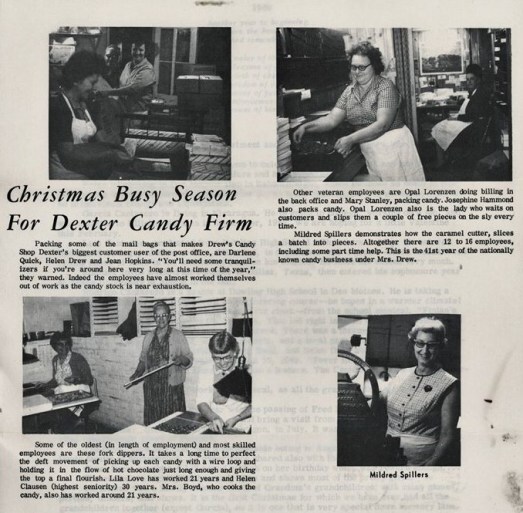 The shop had many different kinds of candy. Many were recipes from Lloyd’s relatives in New Hampshire. Mrs. Drew preferred dark chocolate but my Mom said they sold more milk chocolate than anything else. I should say my Mom worked at Drew’s for 30 years. Some of the candy I remember was: Nougat, Fudge, opera fudge, penuche, caramels, Montevideos, toffee, peanut clusters, cashew clusters, chocolate covered cherries, and of course many different flavored cremes. They also made a candy called rosebuds. They had a pecan caramel called Drew Drops.
The shop had many different kinds of candy. Many were recipes from Lloyd’s relatives in New Hampshire. Mrs. Drew preferred dark chocolate but my Mom said they sold more milk chocolate than anything else. I should say my Mom worked at Drew’s for 30 years. Some of the candy I remember was: Nougat, Fudge, opera fudge, penuche, caramels, Montevideos, toffee, peanut clusters, cashew clusters, chocolate covered cherries, and of course many different flavored cremes. They also made a candy called rosebuds. They had a pecan caramel called Drew Drops.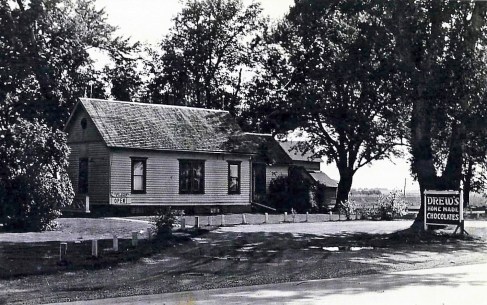 All the candy was sold from the shop. There was once that someone convinced Mrs. Drew to sell her candy in other towns. She sent some to Atlantic and the word got back to her that they had allowed the candy to melt. That was the end of selling outside of Dexter. She would close the shop for the Summer as she felt the heat would hurt the quality of the candy. Plus that was when Mrs. Drew did her fishing. They would start up in September to gear up for the holiday season. Their advertising was former customers spreading the word and there was no lack of customers. They shipped out, I don’t even want to guess how much, chocolate all over the world. She sent out reminders to customers to get their orders early for the holidays, including Valentines Day. Otherwise you might get left out.
All the candy was sold from the shop. There was once that someone convinced Mrs. Drew to sell her candy in other towns. She sent some to Atlantic and the word got back to her that they had allowed the candy to melt. That was the end of selling outside of Dexter. She would close the shop for the Summer as she felt the heat would hurt the quality of the candy. Plus that was when Mrs. Drew did her fishing. They would start up in September to gear up for the holiday season. Their advertising was former customers spreading the word and there was no lack of customers. They shipped out, I don’t even want to guess how much, chocolate all over the world. She sent out reminders to customers to get their orders early for the holidays, including Valentines Day. Otherwise you might get left out.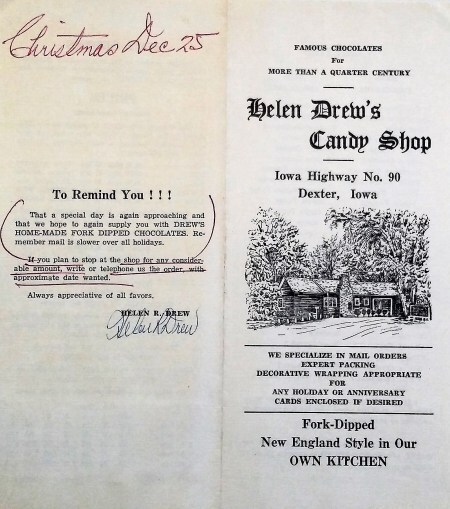 Mrs. Drew employed many people. She picked out people who wanted to work hard and take pride in the product they were making. Most of employees were ladies from the Dexter area. She had 15 people and then employed more during the holidays. I read somewhere that you had to be on your toes and keeping busy because you never knew when Mrs. Drew was going to be showing up. Quality was her goal!What started out as a hobby ended up a “Sweet Success Story.”—–Drew’s Chocolates is still in business along White Pole Road in Dexter, Iowa.
Mrs. Drew employed many people. She picked out people who wanted to work hard and take pride in the product they were making. Most of employees were ladies from the Dexter area. She had 15 people and then employed more during the holidays. I read somewhere that you had to be on your toes and keeping busy because you never knew when Mrs. Drew was going to be showing up. Quality was her goal!What started out as a hobby ended up a “Sweet Success Story.”—–Drew’s Chocolates is still in business along White Pole Road in Dexter, Iowa.
February 4, 2022
Those Peterson Boys: Brothers and Books
I actually “met” younger brother Dennis first, enjoying stories about his growing up years in his memoir.
Dennis Peterson
 Dennis L. Peterson is an independent author, historian, and editor with several publications in regional and national journals and magazines. A former history teacher and curriculum writer, his areas of special interest include Southern history, the War Between the States, the Great Depression, and World War II.
Dennis L. Peterson is an independent author, historian, and editor with several publications in regional and national journals and magazines. A former history teacher and curriculum writer, his areas of special interest include Southern history, the War Between the States, the Great Depression, and World War II.
He also served as senior technical editor for Lockheed Martin Energy Systems, Inc. at the historic Oak Ridge, Tennessee, nuclear facilities. Dennis lives in Taylors, South Carolina, where he is a member of several historical organizations. He is on the board and a docent for History Museum of Travelers Rest.
Dennis is married, has four grown daughters, and several grandchildren.
Look Unto the Hills: Stories of Growing Up in Rural East Tennessee
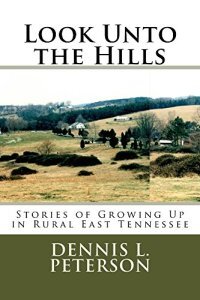 My Thoughts: This delightful memoir is composed of 51 essays, divided into seven sections: Farm Stories, Play, School, Work, People, Animals, and Values. Among the compelling stories is one about his parents hosting a real European prince, the sting of Merthiolate, playing “backyard brigadier,” being chosen as a patrol boy, the very real dangers of following an older brother’s ideas.
My Thoughts: This delightful memoir is composed of 51 essays, divided into seven sections: Farm Stories, Play, School, Work, People, Animals, and Values. Among the compelling stories is one about his parents hosting a real European prince, the sting of Merthiolate, playing “backyard brigadier,” being chosen as a patrol boy, the very real dangers of following an older brother’s ideas.
Here’s his brother Dale’s review: “A very interesting book, indeed – mostly because I lived through many of these stories along side my younger brother Dennis!”
Our American Stories: I was so taken with Dennis Peterson’s memoir that I suggested he record a few memories for them. He did, and they are wonderful to listen to! Check out his website, where those audios are featured, as well as Dennis’s other books.
Dale Peterson
 Dale, the older Peterson brother, is a husband, father of five children, grandfather, author, and international speaker for schools, churches, and conferences. One son, USMC Captain Justin Dale Peterson was killed in 2006, while serving in Iraq.
Dale, the older Peterson brother, is a husband, father of five children, grandfather, author, and international speaker for schools, churches, and conferences. One son, USMC Captain Justin Dale Peterson was killed in 2006, while serving in Iraq.
Dale Peterson has spoken in various capacities in all fifty states and 29 foreign countries. With over 30 years of pastoral experience, Dale identifies with the passions and problems that pastors encounter, and is an encourager of pastors globally, whether speaking in the local church or at conferences.
Although much of the year is spent outside of the United States, Dale is most passionate about America. For more than 25 years Dale and his children toured the contiguous 48 states presenting a one-hour patriotic show called A SALUTE TO AMERICA! in churches and civic organizations, especially around such American holidays as Memorial Day, Fourth of July, and Veterans Day.
Dale also has a personal blog and does guest writing for various religious publications.
Leave a Well in the Valley: Turning Your Tragedies into Triumphs
 My Thoughts: Because the author has been through it all–loss of a marriage, a son killed in Iraq, miserable health problems, depression, false accusations–he uses his experiences to encourage readers that they too can survive. And through the healing that goes along with it, they can be beacons for those who are experiencing similar life crises.
My Thoughts: Because the author has been through it all–loss of a marriage, a son killed in Iraq, miserable health problems, depression, false accusations–he uses his experiences to encourage readers that they too can survive. And through the healing that goes along with it, they can be beacons for those who are experiencing similar life crises.
This memoir would be especially useful for a person serving in a church, but encouraging for anyone in the process of going through deep personal valleys.
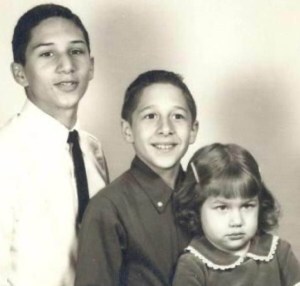 Dale and Dennis have a sister, Gina, who looks more skeptical about the photographer than about those ornery brothers.
Dale and Dennis have a sister, Gina, who looks more skeptical about the photographer than about those ornery brothers.
January 31, 2022
Penpals!
During the 1950s, fifth and sixth graders received My Weekly Reader at school, which was a fun weekly educational classroom magazine. It began in 1928 as My Weekly Reader. Editions covered curriculum themes in the younger grade levels and news-based, current events and curriculum themed-issues in older grade levels.
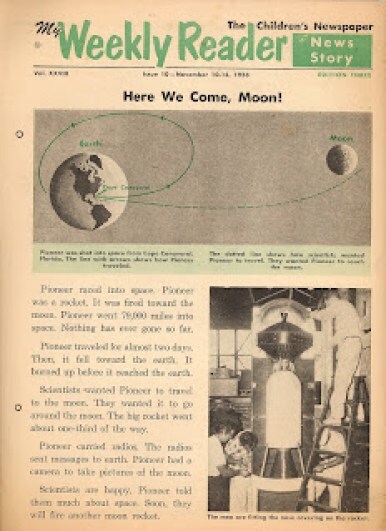
You could send in jokes, which I did from time to time and some were published.
You could also sign up to become a penpal. I wrote letters to half a dozen girls, two of them overseas. My little 1957 diary reminds me of their names: Sharon from Morenci, Arizona; Nada Jean from Virginia, Idaho; Mary Louise from Hooper, Nebraska; Dixie from Downey, Idaho; Carol Jean from Hawkeye, Iowa; Anne from Douglas, Massachusetts; Joelle Muzy from Bourg en Bresse, Ain, France; and Erlinda Yapp from Cavite City, Philippines.
 It took a long time for mail to get back and forth to the overseas pals. Joelle wrote in French, which my piano teacher, Elinor Chapler, would translate for me. I mentioned popcorn once and Joelle didn’t understand what that was, so Mom helped me get Jiffy-Pop ready to send to France.
It took a long time for mail to get back and forth to the overseas pals. Joelle wrote in French, which my piano teacher, Elinor Chapler, would translate for me. I mentioned popcorn once and Joelle didn’t understand what that was, so Mom helped me get Jiffy-Pop ready to send to France.
Can you imagine what fascinating letters an 11-year-old farm girl from Iowa wrote in the 1950s? I remember keeping a chart of activities to make sure I told each one of them all my fascinating happenings, so I wouldn’t repeat the same thing in my next letter.
Visits to cousins or grandparents, going to church, piano lessons?
The two girls from Idaho must have enjoyed getting my letters. At least they stuck around the longest.
How delightful as a child to our rural mailbox and find a letter addressed just to me, with an interesting stamp (which had been licked to affix it), and an exotic postmark.
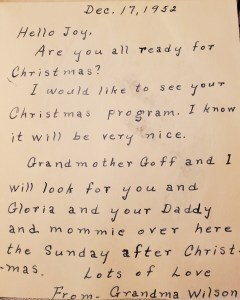 My earliest penpal was Grandma Leora Wilson. We both enjoyed writing letters, so our penpal-ness lasted for decades.
My earliest penpal was Grandma Leora Wilson. We both enjoyed writing letters, so our penpal-ness lasted for decades.
I was just reminded that these days I’ve got electronic penpals from all over. How I appreciate them!
January 27, 2022
“Letters From Uncle Dave,” a Engrossing Book by Phil Rosenkrantz
Letters From Uncle Dave
The 73-Year Journey to Find a Missing in Action World War II Paratrooper
by Phil Rosenkrantz
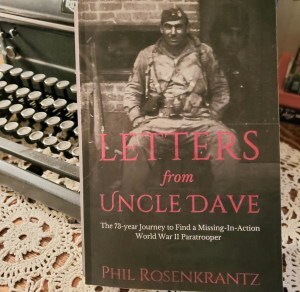 Letters From Uncle Dave is not only the story of a young American serving in WWII, it’s a family story about what happens when that MIA or KIA telegram arrives. And how it permeates through the family when he’s never found and the family is left in limbo, dealing with an ambiguous loss and unresolved grief that even effects more generations.
Letters From Uncle Dave is not only the story of a young American serving in WWII, it’s a family story about what happens when that MIA or KIA telegram arrives. And how it permeates through the family when he’s never found and the family is left in limbo, dealing with an ambiguous loss and unresolved grief that even effects more generations.
Because my Grandma Leora lost three of her five sons who served in WWII, I can relate to the not knowing, as for one of the brothers, only God knows where his remains lie today.
How encouraging to read about the author’s trips to Europe, to try to learn what he could about his uncle, and to learn how much the Dutch revere the young Americans who helped liberate their homeland. They publicly remember anniversaries and welcome Americans who visit, especially those seeking answers.
This family history and historical journey, aiming for closure by one family, is a real American treasure.
—–
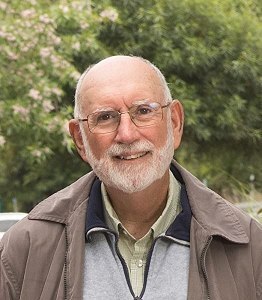
Dr. Phil Rosenkrantz is a devoted educator with a passion for lifelong learning and promoting student success. He especially enjoys traveling and annual backpacking trips. Phil is an avid volunteer with many years of service to the San Gorgonio Wilderness Association (U.S. Forest Service), Boy Scouts, Eastside Christian Schools, the American Society for Quality, and Special Olympics.
He is Professor Emeritus of Engineering at California State Polytechnic University Pomona, where he taught for over 35 years. Prior to teaching, Phil worked for General Motors for ten years in engineering and management. Phil and his wife, Judy, have four children: David, Julia, Sarah, and Debi. His other passions include World War II history, bluegrass, and Disneyland. Phil and Judy now divide their time between Southern California and Central Arizona.
Please visit his website.
“Letters From My Uncle,” a Engrossing Book by Phil Rosenkrantz
Letters From My Uncle
The 73-Year Journey to Find a Missing in Action World War II Paratrooper
by Phil Rosenkrantz
 Letters From My Uncle is not only the story of a young American serving in WWII, it’s a family story about what happens when that MIA or KIA telegram arrives. And how it permeates through the family when he’s never found and the family is left in limbo, dealing with an ambiguous loss and unresolved grief that even effects more generations.
Letters From My Uncle is not only the story of a young American serving in WWII, it’s a family story about what happens when that MIA or KIA telegram arrives. And how it permeates through the family when he’s never found and the family is left in limbo, dealing with an ambiguous loss and unresolved grief that even effects more generations.
Because my Grandma Leora lost three of her five sons who served in WWII, I can relate to the not knowing, as for one of the brothers, only God knows where his remains lie today.
How encouraging to read about the author’s trips to Europe and to learn how much the Dutch revere the young Americans who helped liberate their homeland. They publicly remember anniversaries and welcome Americans who visit, especially those seeking answers.
This family history and historical journey, aiming for closure by one family, is a real American treasure.
—–

Dr. Phil Rosenkrantz is a devoted educator with a passion for lifelong learning and promoting student success. He especially enjoys traveling and annual backpacking trips. Phil is an avid volunteer with many years of service to the San Gorgonio Wilderness Association (U.S. Forest Service), Boy Scouts, Eastside Christian Schools, the American Society for Quality, and Special Olympics.
He is Professor Emeritus of Engineering at California State Polytechnic University Pomona, where he taught for over 35 years. Prior to teaching, Phil worked for General Motors for ten years in engineering and management. Phil and his wife, Judy, have four children: David, Julia, Sarah, and Debi. His other passions include World War II history, bluegrass, and Disneyland. Phil and Judy now divide their time between Southern California and Central Arizona.
January 26, 2022
Iowa’s Six Littleton Brothers, All Lost as a Result of the Civil War
All six of Iowa’s Littleton brothers died as a result of the Civil War.
John Busbee wrote an award-winning story about them for Iowa History Journal. He’s also working on a book, but has already done a great deal to make sure the brothers are never forgotten.
He has shared his 16-minute story about the brothers with Our American Stories.

Here’s more information about making sure the Littleton brothers are remembered, from John Busbee’s The Culture Buzz website:
“The Littleton Brothers Legacy Project (roles: writer, author, producer) – This project began while researching for an Iowa History Journal cover story about six Iowa brothers who all served in the American Civil War, and who all perished because of their service.
“A dedicated group of volunteers, the Littleton Advisory Committee of the Louisa County Historical Society, in Louisa County, Iowa, needed a catalyst to help move their efforts to preserve this story. I was commissioned to help this group with written material and lead efforts to raise funds for a permanent monument dedicated to these six brothers, next to the Toolesboro Mounds National Historic Landmark.
“With the 2014 official project launch, and publishing of the Iowa History Journal story, 2015 was spent developing the project. Successful fundraising efforts led to installation of the Littleton Memorial on Flag Day of 2016. A successful highway signage campaign placed several markers directing travelers to the monument.
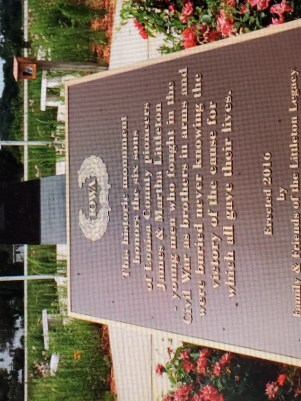
“To continue raising awareness, a story I submitted to the national publication, Civil War News, garnered front page placement, and 2017 saw the collaboration with musician Chad Elliott to create a 5-song EP album, ‘Unequaled Sacrifice,’ to further raise awareness and funds for this project.
“2018 will see the release of an historical novel I will author based on the Littleton Brothers story, ‘Unequalled Sacrifice.’ This project will continue with additional outreach and promotional elements because of the significance of this Iowa and American story, and this story serving as a destination-worthy history to encourage cultural tourism to Louisa County.
“This project includes collaborative efforts with the Littleton Advisory Committee, the Louisa County Board of Supervisors, local veterans organizations, the Louisa County Historical Society, State of Iowa, the Terry E. Branstad Iowa History Fund, several private foundations, and the Keep Iowa Beautiful Foundation.”
January 24, 2022
Winter in Northern Minnesota, Leora in the early 1900s
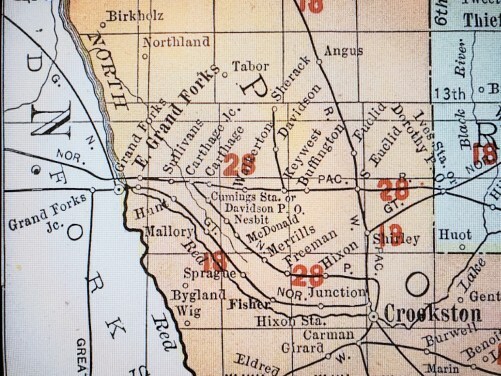 1904 map showing the railroads in Polk County, Minnesota
1904 map showing the railroads in Polk County, MinnesotaLeora Goff was 12 when her father, Sherd (who suffered from wanderlust) decided they’d move (along with other families) from Guthrie County, Iowa, nearly to Canada–to Key West, Minnesota. Typically, farm families made their moves in time to be settled by March 1.
The Goff family moved there from Iowa by train. Sherd and his father, John B. Goff, took the livestock up first. “Pa and Grandpap left with a stock car train a week or more before we did,” Leora wrote in her memoir. “There were two cows, some chickens, and household goods. We stayed at Grandpap Jordan’s [at Monteith] a few days and left by train about March 20th. It was nice spring weather in Iowa. We had a wait of a few hours in St. Paul, Minn., and some or all of us were getting colds, even Grandmother Goff.”
Laura–pregnant again–and her mother-in-law had started out with eight healthy children.
Blizzard
The Northern Pacific Railroad ran right through Key West, which was 13 miles east of Grand Forks, North Dakota. By the time they were met there at the station–by Grandpap Goff driving horses and pulling a cutter loaded with comforters–a blizzard had come up. Their new home was only half a mile north, but Leora said that arriving that way mixed up her sense of direction the whole time they lived in Minnesota.
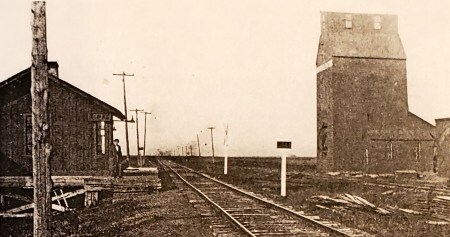 Key West depot and elevators in the 1920s. From “Bicentennial History of Polk County, Minnesota: Pioneers of the Valley” by the Polk County Historical Society, 1976
Key West depot and elevators in the 1920s. From “Bicentennial History of Polk County, Minnesota: Pioneers of the Valley” by the Polk County Historical Society, 1976It was too dangerous for the kids to go to school there during the winter, so that winter of 1903-1904, Leora boarded in Fisher, a town ten miles south of Key West. Talking to a blacksmith one day, Sherd had found a German family with two small children for his oldest child to board with.
Leora enjoyed living with the family, but the 13-year-old experienced homesickness for the first time. A letter arrived from her sister Georgia, “Don’t be homesick. You will soon be home setting hens for Mamma.”
“That did it,” Leora wrote decades later, “I burst out crying, and the lady I was staying with felt so sorry for me and did things to make me feel better. When I would go home with the George Wright (cousins) for the weekend, that helped a lot–we had such good times together–a large family like I was used to.”
Another Blizzard
One weekend, another girl from Key West wanted to go home. She was somewhat older than Leora and arranged to take the train to Grand Forks. “It was nice and clear when we left Fisher but an old fashioned Minnesota blizzard struck and, in northern Minnesota, flat country, a blizzard was dangerous. All the trains were snowbound and we were in Grand Forks, North Dakota, snowbound, with very little money.
“This girl was 18 or 19 years old (I was 13 years old) and happened to have a cousin who was working someplace in the town and she got in touch with him. He took us to a hotel to stay the night. The blizzard was still raging ’til it cleared away on Sunday afternoon. This cousin, I guess, worked at a livery barn, as he found a man from near our territory who had been stranded and was going home in the late afternoon. It was dark when we got to our place (he drove a team and sled). I was so glad to get home and was hungry as we hadn’t eaten since morning–our money was used up.
“The next day it was bright and clear and cold. Pa took me back to Fisher to school in a ‘cutter’ sleigh and team, all bundled up. It was only ten miles but seemed like a hundred would with a car. My stockings were frozen to my heels–you could even see frost. I had ‘chilblains’ for some time after that. A pretty good cure is to boil potato peelings and soak their feet. The lady who I stayed with first at Fisher was so good and helpful.”
1904
“We were getting rather homesick for Iowa,” Leora wrote. “We moved to Fisher the last winter we were in Minnesota, 1904 and 1905. We enrolled in school as they had school in towns in winter. . . .
“We skated and played on the ice of the Red River, which ran north and eventually into Hudson Bay. Pa paid our share for keeping snow off the skating area. It was lots of fun and exercise. Some used sleds as we did sometimes. It was a long winter and there was lots of snow.”
The Goff family returned to Iowa in 1905, but with nine children. Perry Goff was born the first year they lived in Minnesota. And yes, Leora’s mother was pregnant again.
January 21, 2022
Photojournalist David LaBelle, His Novel, and His Photography Wit and Wisdom
Dave LaBelle’s new project is mentioned at the bottom. Check it out. You might like to invest in it!
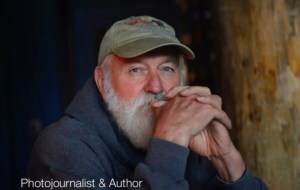
Dave LaBelle is a photojournalist and has worked for 20 newspapers and magazines in nine states. In 1989 while at Western Kentucky University, he published the first edition of The Great Picture Hunt. He’s the author of Lessons in Death and Life, about the ethics of photographing grief. In 1991, the NPPA honored LaBelle with the Robin F. Garland Award for photojournalism education.
In 2009, he published I Don’t Want to Know All That Technical Stuff, I Just Want to Shoot Pictures, an easy-to-read book about basic photography skills designed for beginners. Most recently, David published his first novel, Bridges and Angels: The Story of Ruth, in 2019.
He teaches and directs the photojournalism program at Kent State University in Ohio.
Photojournalist
My Thoughts: Since I rarely take pictures, I didn’t think I’d be very interested in Dave’s photography books, with their explanations of fstops and such. There’s very little about cameras in them, but they are chocked full of learning to look and think about taking pictures, and a lot about life as a human being as well.

The Great Picture Hunt 2, “The art and ethics of feature picture hunting,” is a delightful melding of black and white photos with stories and words of wisdom. Not only for someone interested in commercial photography, or even learning about photography, this book covers so many facets of living with curiosity and imagination.
Divided into eight sections, it covers curiosity, compassion, composition, and character to captioning. Emotion and eavesdropping to ethics. Humor to how and what to hunt for photos. A beautiful book.

I don’t want to know all the technical stuff. . . I just want to shoot pictures,“The TLC approach to taking great photographs at any age”
I don’t understand the bells and whistles of cameras, and I don’t want to take the time to learn any of it. But this little book looked promising, a way to learn something about the photos I take will my “smart” phone without wading through details about film speeds, etc.
This charming book is just perfect, with delightful photos and winsome writing. Dave LaBelle teaches the difference between “artist and accident,” that pictures tell stories, that “without light, there is neither life or photography.” Surely these little tweaks will make my photos better. I didn’t even know the before-and-after-sunrise-and-sunset trick.
The Novel
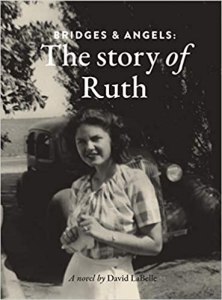
David LaBelle’s first novel Bridges and Angels: The Story of Ruth blurs the line between fiction and memoir as he rewrites the ending to his own childhood tragedy. The Story of Ruth explores what could have happened when the author’s mother disappeared in a California flood during his senior year, in 1969.
My Thoughts: Haunting and even tormenting at times, this story, which has at it core a real nightmare from the author’s past, also carries with it a redemptive beauty. The author’s gift of photography shows up in compelling similes, giving the reader the experiences right along with the characters. Unforgettable images and drama. The nursing home scenes are so tastefully wrought.
Dave tells the 16-minute backstory of his novel on Our American Stories. He shares ways that others may also cope with tragedies, and even change their own stories.
Here’s Dave’s website, where you can learn what else he’s up to. Be sure to watch the two short videos about his new project, “A Visual Walk With Christ.”



